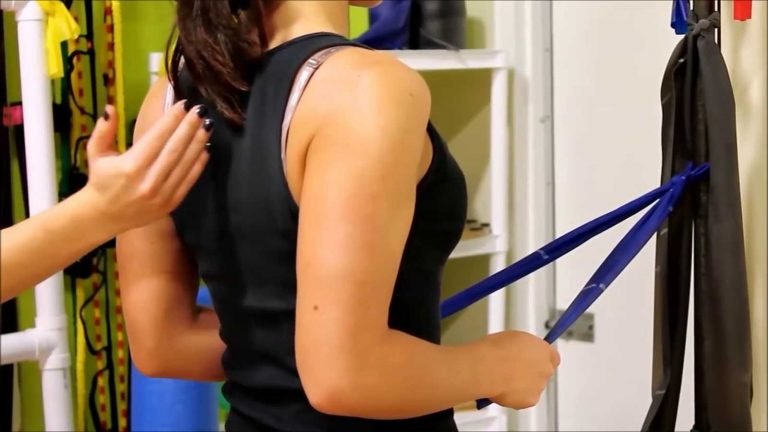
What is Shoulder Impingement Syndrome?
Shoulder impingement syndrome occurs when the soft tissues of the shoulder joint and surrounding areas are repeatedly compressed by the surrounding bones. This problem typically occurs when the arm is raised approximately halfway overhead.
Shoulder impingement syndrome can limit your ability to fully lift your arm or use it in demanding positions such as throwing a ball or writing on a board.
This condition commonly results in inflammation of the rotator cuff tendons, especially the supraspinatus tendon (supraspinatus tendinopathy or tendonitis), particularly in individuals over 40 years old. It can also cause inflammation of the subacromial bursa (subacromial bursitis) in individuals under 40 years old.
What causes Shoulder Impingement Syndrome?
Shoulder impingement syndrome can occur for various reasons.
One reason is that the space between the acromion (shoulder blade arch) and the humerus (upper arm bone) becomes narrower than normal.
This narrowing can lead to irritation and damage to the rotator cuff tendons, resulting in a painful reaction.
The narrowing of the space can be caused by changes in bone structures, such as movements of the AC joint (acromioclavicular), or changes in soft tissues such as thickening of the subacromial bursa or loss of function in the rotator cuff or scapular muscles.
Poor posture: Habitual slouching or a hunched posture leads to poor functioning of the scapular muscles and triggers shoulder impingement.
Activity change: A sudden increase in overhead activities can provoke impingement issues.
Diagnosis of Shoulder Impingement Syndrome
Lifting the arm, especially sideways, will be painful if shoulder impingement is present. The pain worsens between 60 to 120 degrees of elevation.
The pain from shoulder impingement syndrome can also worsen at night, particularly if you lie on the affected shoulder, which may cause sleep disturbances.
If you injure your shoulder, the pain is acute and appears quickly. If there is no injury, the pain gradually increases with repeated or sustained overhead activities.
You may also feel clicking or grinding when moving the shoulder, though these sensations alone are not necessarily problematic.
A physiotherapist will perform several tests to confirm the diagnosis. One of these is the “Empty Can Test,” in which you raise your arms sideways with thumbs pointing down, and the therapist applies pressure.
Pain during this test indicates supraspinatus inflammation.
Another is the Hawkins-Kennedy Test, in which the physiotherapist places the arm forward and supports it while gently rotating the forearm downward.
If this test is painful, the therapist may suspect bursa inflammation.
It’s important to note that no single test can diagnose all problems. The body’s response to various clinical tests
helps the physiotherapist offer the best treatment.

Shoulder Impingement Tests
To diagnose shoulder impingement syndrome, doctors use the following clinical tests:
Neer Test:
The doctor lifts the patient’s arm upward and checks for pain in the front of the shoulder.
Hawkins-Kennedy Test:
The patient’s arm is bent at a 90-degree angle. Then the doctor rotates the arm inward to test pressure on the tendons and bursa.
Painful Arc Test:
The patient lifts their arm. If pain is felt between 60 to 120 degrees, impingement is likely.
MRI or Ultrasound:
If necessary, imaging is used to examine tendon and bursa damage more precisely.
What is Shoulder Nerve Impingement?
Shoulder nerve impingement usually results from pressure on the nerves running from the neck to the shoulder. Symptoms include pain, muscle weakness, and numbness. Treatment methods include:
Rest and posture adjustment:
Avoid repetitive movements and pressure on the shoulder.
Neck and shoulder stretching exercises:
Stretching muscles around the neck and shoulder to reduce nerve pressure.
Manual therapy:
Massage and muscle release by a physiotherapist.
Medication:
Use of anti-inflammatory drugs to reduce nerve area swelling.
Surgery:
In severe cases, surgery may be required to release the nerve.
Treatment for Shoulder Impingement Syndrome
Shoulder impingement syndrome is one of the most common shoulder problems, typically caused by tendon or bursa entrapment beneath the acromion (part of the scapula). Treatment varies based on the severity and individual condition and includes the following methods:
-
Rest and reduction of aggravating activities
Avoid activities that cause shoulder pain, such as lifting heavy objects or repetitive overhead movements. -
Cold or heat compresses
Cold compresses help reduce inflammation and pain in the acute phase.
After inflammation decreases, heat compresses can improve blood flow and reduce muscle tightness. -
Anti-inflammatory medications
Drugs like ibuprofen or naproxen help reduce inflammation and pain. -
Physiotherapy
Strengthening and stretching exercises to improve shoulder mobility.
Specific exercises to strengthen the rotator cuff and surrounding muscles. -
Corticosteroid injection
In severe cases, anti-inflammatory injections into the bursa or affected area can reduce inflammation and pain. -
Surgery
If non-surgical treatments fail, surgery may be necessary to remove obstructions and correct bone structure or repair tendons.
Physiotherapy for Shoulder Impingement Syndrome
Pain management
The goal of physiotherapy is initially to reduce pain and inflammation and prevent further irritation and tissue damage.
The physiotherapist will likely recommend modifying some activities, resting, and applying ice to the shoulder.
To help reduce pain and relax the shoulder, neck, or spine (between the shoulder blades), the specialist may use muscle massage or manual joint therapy.
You may find that using ice or heat in the acute phase helps. There’s no evidence that one treatment is superior, so personal preference determines effectiveness.
The physiotherapist may use low-level laser therapy to reduce pain and inflammation around the tendon.
Postural or positional change
Using tape to create more space for the inflamed tendon or bursa is helpful for changing shoulder alignment.
The physiotherapist will provide simple strategies to change posture and prevent severe pain.
This improves scapular muscle activity and reduces inflammation.
Some strategies include lifting the sternum or imagining zipping up from the navel to the lower ribs.

Shoulder strengthening and rehabilitation
A complete shoulder rehab program always includes some strengthening exercises. The physiotherapist will provide resistance bands to strengthen the scapular and rotator cuff muscles, and the range of exercises will progress as symptoms improve (to the extent you can move).
Then you’ll begin resistance training using different colored bands, and the exercises will become more functional.
None of these exercises should be painful. If you experience issues, inform your physiotherapist.
If you engage in overhead sports (like tennis or volleyball), the physiotherapist will begin strengthening gluteal muscles, as stronger glutes reduce the force needed from the shoulder muscles.
Your physiotherapist may use biofeedback (a device that measures muscle activity) to give you more information on how your muscles work and help increase activity, particularly in the scapular muscles.
If you regularly participate in overhead sports, the physiotherapist may video record your technique, which helps minimize impingement and improve performance.
Effectiveness of Physiotherapy for Shoulder Impingement Syndrome
Physiotherapy has been shown to be effective for shoulder impingement syndrome.
According to a 2014 study, patients who underwent physiotherapy had fewer impingement episodes and fewer doctor visits (37% vs. 60%) one year after injury compared to those initially treated with corticosteroid injections.
Patients who received injections often required additional injections due to recurrence of symptoms.
Manual therapy used by physiotherapists is effective for pain relief due to shoulder weakness, but there is limited evidence supporting electrotherapy, except for low-level laser therapy.
Home exercises combined with regular physiotherapy consultation, based on a gradual strengthening and stretching program, are effective in maintaining and improving the condition.
Corrective Exercises for Shoulder Impingement Syndrome
The following exercises can improve shoulder posture and reduce impingement. These should be done under the guidance of a doctor or physiotherapist:
-
Wall Stretch Exercise
Stand facing a wall and place your hand on it.
Slowly raise your arm upward until a mild stretch is felt in the shoulder.
Repeat this movement 10 to 15 times. -
Pendulum Exercise
While standing, bend forward and relax the affected arm.
Gently swing your arm in small circles like a pendulum.
Do this for 1 to 2 minutes. -
Resistance Band Stretch
Tie a resistance band to a door handle.
Attach your hand to the band and slowly pull it toward your body.
Repeat in 3 sets of 10. -
Rotator Cuff Strengthening Exercise
Lie on your side and hold a light dumbbell.
Slowly raise your arm away from your body and return to the starting position.
Repeat 10 to 15 times.
Treatment for Shoulder Tendon Impingement
Shoulder tendon impingement usually results from inflammation or damage to the rotator cuff tendons. Treatment methods include:
-
Anti-inflammatory medications
Drugs like ibuprofen and topical gels are effective in reducing inflammation. -
Stretching and strengthening exercises
Corrective exercises to increase flexibility and strengthen shoulder muscles. -
Orthopedics and physiotherapy
Use of braces or support tapes to stabilize the shoulder.
Manual therapy and massage by a physiotherapist. -
Corticosteroid injection
Used to reduce inflammation in chronic cases. -
Surgery
If there is a severe tendon tear, surgical repair is necessary.
What Can I Do at Home?
You can ensure better posture while sitting and standing. You can also stand in the third modified ballet position to ensure parts of your feet touch, which helps avoid slouching.
Some people feel better by opening their shoulders, while others find lifting the sternum while lifting an object helps relieve pain.
For range-of-motion strengthening exercises, place your hands on your hips, then stretch them forward, place them behind your head, push elbows back, extend arms to the sides, and slowly lower them.
Do this twice a day, two repetitions each time. If straightening arms to the sides causes pain, don’t push elbows back, as this exercise should not be painful.
Sometimes you may not notice overactivity in the shoulder blade muscles. You can raise your shoulders to your ears while inhaling, then slowly lower them with exhalation.
This reduces tension around the neck and shoulders.
Overall, the best home treatment is an exercise program prescribed by a physiotherapist based on your individual condition and capacity.
How Long Does Recovery Take?
Shoulder impingement is due to tendon or bursa inflammation, so you must avoid repeatedly inflaming these structures.
Shoulder impingement, if managed with better posture and avoidance of frequent overhead use, typically resolves relatively quickly (6 to 12 weeks).
If you participate in overhead sports, recovery will take longer as your technique must be continuously refined to avoid re-inflammation of the structures.
If you’d like this as a downloadable file or formatted document, I can help with that too.



نظر خود را بگذارید